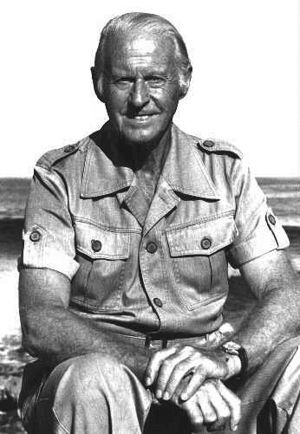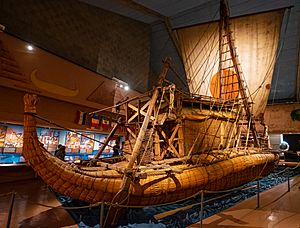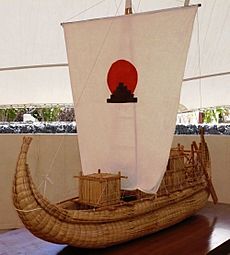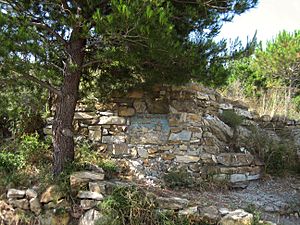Thor Heyerdahl facts for kids
Quick facts for kids
Thor Heyerdahl
|
|
|---|---|

Heyerdahl around 1980
|
|
| Born | 6 October 1914 Larvik, Norway
|
| Died | 18 April 2002 (aged 87) Colla Micheri, Italy
|
| Nationality | Norwegian |
| Alma mater | University of Oslo |
| Spouse(s) |
Liv Coucheron-Torp
(m. 1936; div. 1947)Yvonne Dedekam-Simonsen
(m. 1949; div. 1969)Jacqueline Beer
(m. 1991) |
| Children | 5 |
| Awards | Mungo Park Medal (1950) |
| Scientific career | |
| Fields | |
| Doctoral advisor |
|
Thor Heyerdahl (born October 6, 1914 – died April 18, 2002) was a famous Norwegian adventurer and ethnographer. An ethnographer studies different cultures and peoples. He also had a background in zoology (animals), botany (plants), and geography (Earth's features).
Heyerdahl is best known for his amazing Kon-Tiki expedition in 1947. During this trip, he sailed 8,000 kilometers (5,000 miles) across the Pacific Ocean. He used a raft he built himself, traveling from South America to the Tuamotu Islands. He wanted to show that ancient people could have made long sea voyages. This would mean different cultures could have connected with each other across oceans.
He made other voyages to prove his ideas. One famous trip was the Ra II expedition in 1970. He sailed from Africa to Barbados in a boat made of papyrus reeds. Heyerdahl was honored by the Norwegian government in 1984.
He passed away on April 18, 2002, in Italy. The Norwegian government held a special funeral for him. In 2011, his important papers and photos were added to UNESCO's "Memory of the World" list. This means his work is considered very important for all of humanity. His archives are kept at the Kon-Tiki Museum and the National Library of Norway in Oslo.
Contents
Early Life and Family
Thor Heyerdahl was born in Larvik, Norway. His mother encouraged his early interest in zoology. As a child, he even created a small museum in his home! His main exhibit was a common adder snake.
He studied zoology and geography at the University of Oslo. At the same time, he learned a lot about Polynesian culture and history. He used a huge private collection of books on Polynesia for his studies.
In 1936, Heyerdahl married Liv Coucheron-Torp. They had two sons, Thor Jr. and Bjørn. Their marriage ended before the Kon-Tiki expedition. During World War II, he served with the Free Norwegian Forces.
In 1949, he married Yvonne Dedekam-Simonsen. They had three daughters: Annette, Marian, and Helene Elisabeth. They later divorced. In 1991, Heyerdahl married Jacqueline Beer, his third wife. They lived in the Canary Islands and worked on archaeological projects until his death.
Adventure on Fatu Hiva
In 1936, right after getting married, Thor and Liv Heyerdahl sailed to the South Pacific island of Fatu Hiva. Their goal was to study how animals spread between islands. But they also dreamed of living a simple life in the South Seas.
They lived in a basic, thatch-covered home in a valley called Uia. They learned to live off the land, collecting plants and animals for their studies. They also found old artifacts and listened to local stories. They paid attention to the winds and ocean currents.
It was on Fatu Hiva that Heyerdahl first thought about his big idea. He wondered if people from South America could have traveled across the ocean to Polynesia long ago. He saw similarities between ancient South American and Polynesian cultures.
Living in such a wild place was tough. After a year, they returned home due to challenges like tropical diseases. They wrote a book about their adventure called Fatu Hiva.
The Kon-Tiki Expedition
In 1947, Heyerdahl and five friends built a raft called the Kon-Tiki. It was made from balsa wood and other natural materials, just like ancient rafts. They sailed from Peru to the Tuamotu Islands in French Polynesia. The expedition was inspired by old drawings of Inca rafts and local legends. These suggested that ancient people might have traveled between South America and Polynesia.
The Kon-Tiki crashed into a reef after 101 days at sea. They had traveled about 8,000 kilometers (5,000 miles) across the Pacific Ocean. Heyerdahl had been afraid of water since childhood. He later said he feared for his life many times on his raft voyages.
The journey showed that a simple raft could indeed sail across the Pacific. It was especially easy with the trade winds pushing them west. The raft was easy to steer. Fish gathered between the logs, suggesting ancient sailors could have used them for food and water. Other rafts have since repeated the voyage, inspired by the Kon-Tiki.
Heyerdahl's book about the trip, The Kon-Tiki Expedition, has been translated into 70 languages. The documentary film about the expedition won an Academy Award in 1951. A movie based on the story, also called Kon-Tiki, was nominated for an Oscar in 2012.
Scientists generally believe that Polynesia was settled from west to east, starting from Asia. However, there are some clues that suggest contact between South America and Polynesia. For example, the sweet potato, originally from South America, is a common food in Polynesia. Later DNA studies have also shown some genetic links between Easter Islanders and South Americans. This supports some parts of Heyerdahl's ideas.
Heyerdahl's Ideas on Polynesian Origins
Heyerdahl believed that in ancient Inca stories, there was a sun-god named Kon-Tiki Viracocha. This god was the leader of a mythical group of fair-skinned people in Peru. Heyerdahl thought these "white men" built huge ruins near Lake Titicaca.
According to the legend, Kon-Tiki and his friends escaped a battle and sailed west into the Pacific. When the Spanish arrived in Peru, the Incas told them about these wise, peaceful "white gods." They said these gods had taught their ancestors about building and customs. The Incas described them as having white skin, long beards, and being taller than themselves. These "white gods" then left suddenly, sailing west across the Pacific.
Heyerdahl said that when Europeans first came to the Pacific islands, they were surprised to find some natives with lighter skin and beards. He believed these people were descendants of Tiki's people. He thought Tiki's people, who used large balsa wood rafts, settled the Polynesian islands around 500 AD. They built huge stone statues and pyramids, similar to those in Peru.
However, Heyerdahl also found signs that other groups arrived later. He believed that Native Americans from the Northwest, using large canoes, came to Polynesia around 1100 AD. They mixed with Tiki's people. The oral traditions of Easter Island, as Heyerdahl recorded them, seemed to support this idea.
Heyerdahl also suggested that the main Polynesian people came from Asia. But he thought they traveled along the North Pacific current to British Columbia first. Then, they moved to Polynesia from there.
Easter Island Expedition
In 1955–1956, Heyerdahl led the Norwegian Archaeological Expedition to Easter Island. He and other scientists spent months studying important archaeological sites. They even experimented with carving, moving, and setting up the famous moai stone statues. They also dug at places like Orongo and Poike.
Heyerdahl wrote a popular book about this trip called Aku-Aku. In another book, Easter Island: The Mystery Solved, he shared a more detailed theory. He believed the island was first settled by "Long Ears" from South America. Then, Polynesian "Short Ears" arrived later. He noted that early European visitors saw different groups of people living together. But later visitors found mostly Polynesians living in hardship.
Heyerdahl mentioned an oral story about an uprising where the "Short Ears" fought against the "Long Ears." He claimed the "Long Ears" dug a defensive ditch and filled it with wood. But the "Short Ears" found a way around it and pushed most of the "Long Ears" into the fire. His expedition found evidence of this ditch and fire layers.
DNA tests have shown some connection between Easter Islanders and South America. While most evidence points to Polynesia being settled from Asia, these findings suggest there was some contact with South America.
The Ra and Ra II Boats
In 1969 and 1970, Heyerdahl built two boats from papyrus reeds. He wanted to see if ancient Egyptians could have crossed the Atlantic Ocean. The first boat, named Ra (after the Egyptian Sun god), was built by experts from Lake Chad. It launched from Morocco, Africa. The crew included people from many different countries.
After several weeks, Ra started to take on water and broke apart. The crew had to abandon the boat close to the Caribbean islands. They were rescued by another yacht.
The next year, in 1970, a similar boat called Ra II was built. This time, it was made by builders from Lake Titicaca in Bolivia. Ra II successfully sailed across the Atlantic from Morocco to Barbados. This showed that ancient sailors could have made such long voyages using the ocean currents. The Ra II is now in the Kon-Tiki Museum in Oslo.
Heyerdahl wrote a book, The Ra Expeditions, and a film, Ra, about these journeys. He chose a crew from different races, countries, and religions. He wanted to show that people from diverse backgrounds could work together peacefully. The expedition also collected samples of ocean pollution and reported them to the United Nations.
The Tigris Expedition
In 1977, Heyerdahl built another reed boat, the Tigris. He wanted to show that ancient civilizations in Mesopotamia (modern-day Iraq) could have traded with the Indus Valley Civilization (modern-day Pakistan and India). The Tigris was built in Iraq and sailed through the Persian Gulf to Pakistan and then into the Red Sea.
After five months, the Tigris was still seaworthy. But Heyerdahl decided to burn it in Djibouti on April 3, 1978. This was a protest against the wars happening in the Red Sea and Horn of Africa regions. He wrote an open letter to the United Nations, asking leaders to stop providing weapons to warring nations. He believed that people needed to work together to save our planet.
The Tigris had an 11-person crew from many different countries. Heyerdahl often spoke out about peace and the environment in the years that followed.
"The Search for Odin"
Heyerdahl visited Azerbaijan several times. He was very interested in ancient rock carvings there, which looked similar to carvings in Norway. He thought this meant an advanced ancient civilization existed in Azerbaijan. He believed people from there might have traveled north to Scandinavia in special boats made of animal skins.
He also connected this idea to old Norse stories. A 13th-century historian named Snorri Sturluson wrote that the god Odin and his people came to the North from a land called "Aser." Heyerdahl thought this land of Aser might be in the region of modern-day Azerbaijan. He believed this showed a real historical migration.
In 2001–2002, Heyerdahl started digging in Azov, Russia, near the Black Sea. He was looking for remains of a civilization that matched Snorri Sturluson's story. However, many historians and scientists did not agree with Heyerdahl's "Odin hypothesis." They said his ideas were based on coincidences and not enough scientific proof. Heyerdahl often published his theories in popular books for the public, even if they weren't fully accepted by the scientific community. As of 2021, his Odin hypothesis has not been proven by other historians or archaeologists.
Other Projects and Legacy
Heyerdahl also studied ancient mounds on the Maldive Islands in the Indian Ocean. He found old foundations and statues there. He believed these discoveries supported his idea of a seafaring civilization that influenced cultures in South America and Easter Island.
In 1991, he studied the Pyramids of Güímar on Tenerife in the Canary Islands. He believed they were real pyramids, not just piles of stones. He thought they were built by ancient sun worshippers. Heyerdahl suggested that the Canary Islands might have been a stop for ancient ships traveling between America and the Mediterranean Sea.
Thor Heyerdahl was also active in environmental causes. He received many awards and honorary degrees from universities around the world. He was known for his boat-building experiments and his focus on how cultures spread.
Death
Thor Heyerdahl passed away on April 18, 2002, in Italy. He was 87 years old and died from a brain tumor. After learning about his illness, he chose not to eat or take medicine.
The Norwegian government held a state funeral for him. He is buried in the garden of his family home in Italy.
Lasting Impact
Even though some of his ideas were not accepted by all scientists, Heyerdahl greatly increased public interest in ancient history and anthropology. He showed that long ocean voyages were possible with ancient boat designs. He was a pioneer in experimental archaeology, which means testing old methods to understand the past.
The Kon-Tiki Museum in Oslo, Norway, displays his boats and maps from the Kon-Tiki expedition. It also has a large library of books. The Thor Heyerdahl Institute was created in 2000 to continue his ideas and principles. It is located in his hometown of Larvik, Norway. Larvik has also started projects to honor him, like renovating his childhood home and holding a yearly raft race.
In 2006, Heyerdahl's grandson, Olav Heyerdahl, repeated the Kon-Tiki voyage. This trip, called the Tangaroa Expedition, honored his grandfather. It also helped researchers learn more about ancient navigation and monitor the Pacific Ocean's environment.
Recent scientific research, including DNA studies, has shown that there was indeed some contact between South America and Polynesian islands like Easter Island. This suggests that some of Heyerdahl's ideas about ancient ocean travel might have been correct, even if Polynesia was mainly settled from Asia.
Honors and Awards

Many things have been named after Thor Heyerdahl. These include an asteroid (2473 Heyerdahl), a Norwegian warship (HNoMS Thor Heyerdahl), and a German sail training vessel. A valley on the dwarf planet Pluto is also named Heyerdahl Vallis. His hometown of Larvik has a high school named Thor Heyerdahl Upper Secondary School. In 2014, Google honored him with a special Google Doodle on his 100th birthday.
Heyerdahl received many awards and honors, including:
Governmental and State Honors
- Grand Cross of the Royal Norwegian Order of St Olav (1987)
- Grand Cross of the Order of Merit of Peru (1953)
- Grand Officer of the Order of Merit of the Italian Republic (1965)
- Knight in the Order of Saint John of Jerusalem
- Knight of the Order of Merit, Egypt (1971)
- Grand Officer of the Order of Ouissam Alaouite (Morocco; 1971)
- Officer, Order of the Sun (Peru) (1975)
- International Pahlavi Environment Prize, United Nations (1978)
- Knight of the Order of the Golden Ark, Netherlands (1980)
- Civitan International World Citizenship Award
- Austrian Decoration for Science and Art (2000)
- St. Hallvard's Medal
Academic Honors
- Retzius Medal, Royal Swedish Society for Anthropology and Geography (1950)
- Mungo Park Medal, Royal Scottish Society for Geography (1951)
- Bonaparte-Wyse Gold Medal, Société de Géographie de Paris (1951)
- Elisha Kent Kane Gold Medal, Geographical Society of Philadelphia (1952)
- Honorary Member, Geographical Societies of Norway (1953), Peru (1953), Brazil (1954)
- Elected Member Norwegian Academy of Sciences (1958)
- Fellow, New York Academy of Sciences (1960)
- Vega Gold Medal, Swedish Society for Anthropology and Geography (1962)
- Lomonosov Medal, Moscow State University (1962)
- Gold Medal, Royal Geographical Society, London (1964)
- Distinguished Service Award, Pacific Lutheran University, Tacoma, Washington, US (1966)
- Member American Anthropological Association (1966)
- Kiril i Metodi Award, Geographical Society, Bulgaria (1972)
- Honorary Professor, Instituto Politécnico Nacional, Mexico (1972)
- Bradford Washburn Award, Museum of Science, Boston, US, (1982)
- President's Medal, Pacific Lutheran University, Tacoma, US (1996)
- Honorary Professorship, Western University, Baku, Azerbaijan (1999)
Honorary Degrees
- Doctor Honoris Causa, University of Oslo, Norway (1961)
- Doctor Honoris Causa, USSR Academy of Science (1980)
- Doctor Honoris Causa, University of San Martin, Lima, Peru, (1991)
- Doctor Honoris Causa, University of Havana, Cuba (1992)
- Doctor Honoris Causa, University of Kyiv, Ukraine (1993)
- Doctor Honoris Causa, University of Maine, Orono (1998)
Images for kids
See also
 In Spanish: Thor Heyerdahl para niños
In Spanish: Thor Heyerdahl para niños






